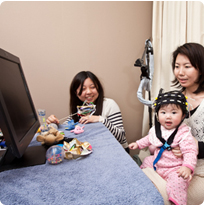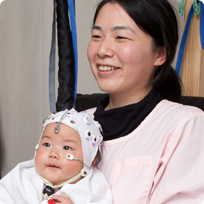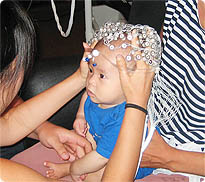We measure what parts of the brain are most active as babies listen to various sounds or words. To do this, we use one of the two methods described below.
※ This procedure is not a test of individual ability.


Near-infrared spectroscopy (NIRS) uses near-infrared light shone on the scalp to measure changes in the hemoglobin content of blood.
Near-infrared light has a wavelength close to that of visible light, and is similar to that used in TV remote controls and kotatsu. The light used in this procedure is weaker than normal sunlight, and has no harmful effects.
Because of its safety, the NIRS technique is used as a blood oxygen monitor for newborns and is used to measure heart rate during exercise.
During the procedure, terminals used to emit and detect light are attached to the baby's scalp. The terminals are extremely soft, and cause no pain to the baby whatsoever.


By attaching electrodes to the scalp, we can measure the electical activity of the brain while babies are looking at or listening to various stimuli.
The procedure consists of simply measuring naturally-produced electromagnetic fields from the surface of the scalp, there is no pain or harm to the baby. During the procedure, the baby wears a cap containing the electrodes, with several additional electrodes attached to the face. Electrodes are affixed to the skin with a safe, water-soluble gel which is easily wiped off with a damp towel when the procedure is done.












